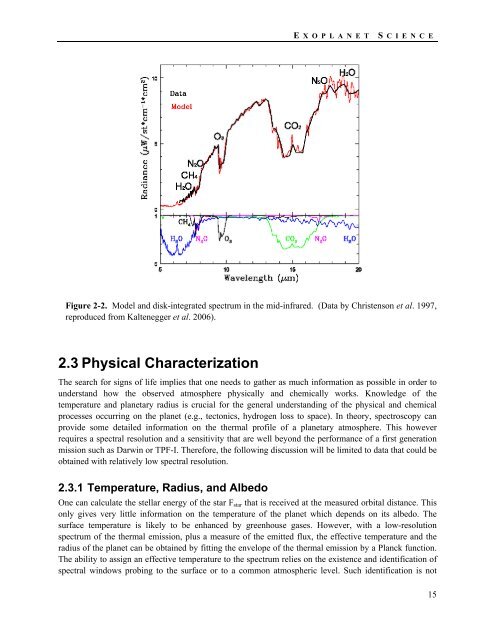TPF-I SWG Report - Exoplanet Exploration Program - NASA
TPF-I SWG Report - Exoplanet Exploration Program - NASA
TPF-I SWG Report - Exoplanet Exploration Program - NASA
You also want an ePaper? Increase the reach of your titles
YUMPU automatically turns print PDFs into web optimized ePapers that Google loves.
E X O P L A N E T S CIENCE<br />
Figure 2-2. Model and disk-integrated spectrum in the mid-infrared. (Data by Christenson et al. 1997,<br />
reproduced from Kaltenegger et al. 2006).<br />
2.3 Physical Characterization<br />
The search for signs of life implies that one needs to gather as much information as possible in order to<br />
understand how the observed atmosphere physically and chemically works. Knowledge of the<br />
temperature and planetary radius is crucial for the general understanding of the physical and chemical<br />
processes occurring on the planet (e.g., tectonics, hydrogen loss to space). In theory, spectroscopy can<br />
provide some detailed information on the thermal profile of a planetary atmosphere. This however<br />
requires a spectral resolution and a sensitivity that are well beyond the performance of a first generation<br />
mission such as Darwin or <strong>TPF</strong>-I. Therefore, the following discussion will be limited to data that could be<br />
obtained with relatively low spectral resolution.<br />
2.3.1 Temperature, Radius, and Albedo<br />
One can calculate the stellar energy of the star F star that is received at the measured orbital distance. This<br />
only gives very little information on the temperature of the planet which depends on its albedo. The<br />
surface temperature is likely to be enhanced by greenhouse gases. However, with a low-resolution<br />
spectrum of the thermal emission, plus a measure of the emitted flux, the effective temperature and the<br />
radius of the planet can be obtained by fitting the envelope of the thermal emission by a Planck function.<br />
The ability to assign an effective temperature to the spectrum relies on the existence and identification of<br />
spectral windows probing to the surface or to a common atmospheric level. Such identification is not<br />
15
















